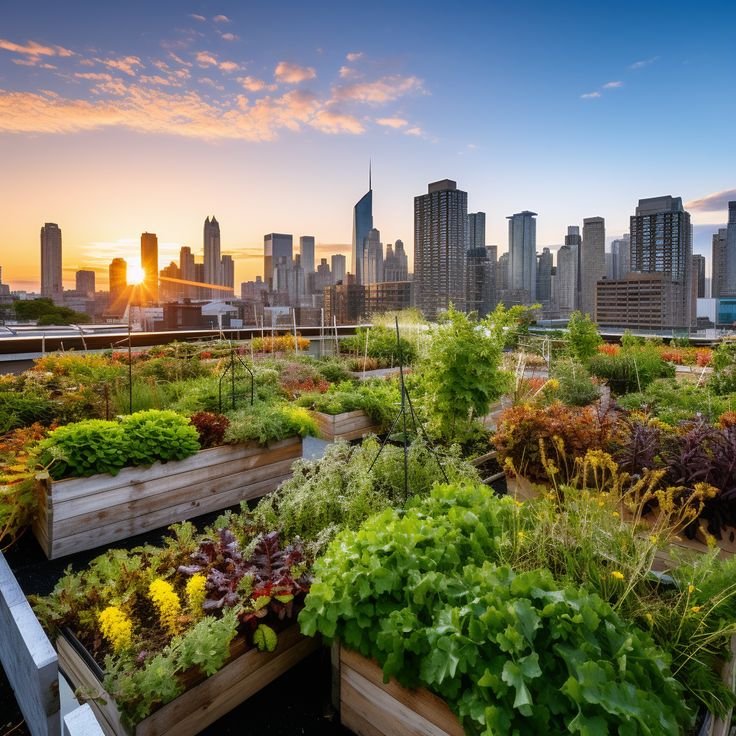Urban Gardening: Transforming City Spaces into Green Havens

Introduction
As urbanization accelerates, cities around the globe face growing challenges, including limited green spaces, rising pollution levels, and food security concerns. With over half of the world’s population residing in urban areas, the need for sustainable solutions that address environmental and social issues has become increasingly critical. One such solution gaining traction is urban gardening. By repurposing city spaces into vibrant green havens, urban gardening offers a way to enhance biodiversity, promote healthier lifestyles, and strengthen community bonds.
Urban gardening is not just about growing plants in confined spaces; it represents a broader movement toward reconnecting with nature and addressing urban challenges. From rooftop gardens to vertical farming, these initiatives demonstrate how innovation and sustainability can coexist in densely populated areas. This article delves into the transformative power of urban gardening, exploring its environmental, social, and economic benefits, as well as practical strategies for implementation.
1. The Environmental Benefits of Urban Gardening
Urban gardening plays a pivotal role in improving the environment within cities. By introducing green spaces, these initiatives combat some of the most pressing ecological challenges faced by urban areas.
1.1. Mitigating Urban Heat Islands
Cities often experience higher temperatures than surrounding rural areas due to the urban heat island effect. Concrete, asphalt, and other artificial surfaces absorb and retain heat, exacerbating temperature disparities. Urban gardens, with their lush greenery, help mitigate this effect by providing natural cooling. Rooftop gardens and green walls, in particular, reduce heat absorption and improve air circulation, leading to cooler microclimates within cities.
1.2. Enhancing Air Quality
Air pollution is a significant concern in urban environments, contributing to respiratory diseases and environmental degradation. Urban gardens act as natural air purifiers, absorbing carbon dioxide and filtering harmful pollutants such as particulate matter and nitrogen oxides. By integrating more greenery into cities, urban gardening initiatives can significantly improve air quality and public health.
1.3. Promoting Biodiversity
Urban gardening provides habitats for pollinators, birds, and other wildlife, supporting biodiversity in otherwise concrete-dominated landscapes. Native plants and flowers attract bees, butterflies, and other beneficial insects, helping maintain ecological balance. These green spaces also serve as vital corridors for wildlife movement, promoting coexistence between urban development and natural ecosystems.
2. Urban Gardening and Food Security
One of the most impactful contributions of urban gardening is its ability to address food insecurity by providing access to fresh, locally grown produce.
2.1. Local Food Production
Urban gardens enable residents to grow fruits, vegetables, and herbs close to home, reducing reliance on long supply chains and decreasing the carbon footprint associated with transporting food. Community gardens, in particular, empower neighborhoods to cultivate shared plots, fostering a sense of ownership and access to fresh produce.
2.2. Reducing Food Waste
Growing food locally encourages mindful consumption and reduces food waste. Surplus produce from urban gardens can be distributed within communities, ensuring that food is utilized rather than discarded. Additionally, urban gardeners can compost organic waste to enrich the soil, creating a circular system that minimizes waste.
2.3. Vertical Farming and Innovation
Technological advancements, such as vertical farming, have revolutionized urban agriculture. Using hydroponic and aeroponic systems, vertical farms maximize food production in limited spaces. These systems require less water and land than traditional farming, making them ideal for densely populated cities. Innovations like these not only improve food security but also make urban gardening more accessible and efficient.
3. Social and Community Impact
Urban gardening extends beyond environmental and food-related benefits; it also fosters social cohesion and improves overall well-being.
3.1. Strengthening Community Bonds
Community gardens bring people together, creating opportunities for collaboration and shared purpose. Neighbors work side by side to cultivate and maintain green spaces, fostering connections that transcend social and cultural differences. These gardens serve as hubs for education, cultural exchange, and mutual support.
3.2. Improving Mental Health
Spending time in green spaces has been shown to reduce stress, anxiety, and depression. Urban gardening offers a therapeutic outlet, allowing individuals to reconnect with nature and find solace in nurturing plants. The act of gardening promotes mindfulness and a sense of accomplishment, contributing to better mental health outcomes.
3.3. Educational Opportunities
Urban gardens provide hands-on learning experiences for people of all ages. Schools and community organizations can use these spaces to teach children about ecology, nutrition, and sustainable practices. Educational workshops on gardening techniques, composting, and water conservation further empower communities to adopt environmentally conscious habits.
4. Practical Strategies for Implementing Urban Gardens
Successfully integrating urban gardening into cityscapes requires strategic planning and community engagement. Several approaches can help maximize the impact and feasibility of these initiatives.
4.1. Repurposing Underutilized Spaces
Vacant lots, rooftops, and unused public spaces offer immense potential for urban gardening projects. By transforming these areas into productive green spaces, cities can enhance aesthetics and functionality while addressing environmental challenges.
4.2. Rooftop and Balcony Gardens
For individuals with limited access to traditional gardens, rooftops and balconies provide excellent alternatives. Container gardening, vertical planters, and hydroponic systems make it possible to grow a variety of plants in compact spaces, enabling urban dwellers to participate in greening efforts.
4.3. Policy Support and Incentives
Governments play a crucial role in promoting urban gardening by implementing supportive policies and offering incentives. Grants, tax breaks, and zoning regulations that encourage green spaces can accelerate the adoption of urban gardening projects. Public-private partnerships can also facilitate funding and resource sharing.
4.4. Community-Driven Initiatives
Engaging local communities in the planning and implementation of urban gardening projects ensures their success and sustainability. Community leaders, non-profits, and local businesses can collaborate to provide resources, training, and support for aspiring urban gardeners.
5. Challenges and Future Directions
Despite its many benefits, urban gardening faces challenges that must be addressed to achieve long-term success.
5.1. Limited Space and Resources
One of the primary barriers to urban gardening is the lack of available land and resources in densely populated areas. Innovative solutions, such as vertical farming and rooftop gardens, are essential for overcoming these limitations.
5.2. Knowledge and Skill Gaps
Not everyone has the expertise required to establish and maintain a thriving garden. Educational programs and community workshops are vital for equipping individuals with the necessary skills and knowledge to succeed.
5.3. Climate and Environmental Challenges
Urban gardens are susceptible to extreme weather conditions, pollution, and water scarcity. Investing in resilient gardening practices, such as using drought-tolerant plants and efficient irrigation systems, can help mitigate these challenges.
5.4. Scaling and Replication
Expanding urban gardening initiatives to reach more communities requires scalability and replicable models. Sharing success stories, best practices, and innovative approaches can inspire other cities to adopt similar programs.
Conclusion
Urban gardening is a transformative movement that redefines how cities interact with nature. By addressing environmental, social, and economic challenges, these initiatives pave the way for greener, healthier, and more connected urban environments. From mitigating urban heat islands to strengthening community bonds, urban gardening demonstrates the power of collective action and innovation in creating a sustainable future.
While challenges remain, the potential of urban gardening to revolutionize city living is undeniable. With strategic planning, community involvement, and continued innovation, cities can transform into green havens that nurture both people and the planet. As urbanization continues to rise, embracing urban gardening is not just an option but a necessity for building resilient and thriving urban ecosystems.




